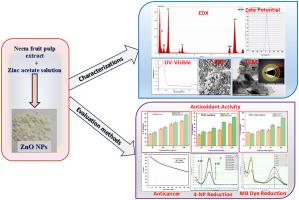Neem fruit pulp extract mediated biosynthesis, characterization of zinc oxide nanoparticles, and evaluation of their antioxidant, anticancer, and catalytic properties
IF 4.2
Q2 CHEMISTRY, MULTIDISCIPLINARY
引用次数: 0
Abstract
Green synthesis of nanoparticles using biological extracts has gained immense attention due to its eco-friendly and simple approach. This study presents a novel, eco-friendly approach for synthesizing ZnO nanoparticles using Neem fruit pulp extract (NFPE) through a solvent combustion method. The synthesized ZnO NPs were characterized using Several characterization techniques, including UV–Vis spectroscopy, FTIR, XRD, SEM, TEM, DLS, and EDX, analysis. The ZnO NPs exhibited a UV–Vis absorption peak at 367 nm, confirming nanoparticle formation. FTIR analysis revealed functional groups in Neem fruit pulp extract that significantly contribute to the stabilization of the synthesized nanoparticles, and XRD revealed a hexagonal wurtzite structure with an average crystalline size of 42 nm. SEM and HR-TEM analyses showed spherical and rod-like morphologies with an average size of 35.5 nm, while DLS indicated a hydrodynamic size of 41.5 nm with a zeta potential of 15.1 mV. NFE-ZnO NPs demonstrated significant antioxidant activity (IC50 values: DPPH = 68.30 μg/mL, H₂O₂ = 84.59 μg/mL, NO = 77.63 μg/mL). In the anticancer assay, a dose-dependent inhibition of A549 cells (lung cancer cells) was observed, with an IC50 value of 50.2 μg/mL. The catalytic activity showcased efficient degradation of cotton blue dye and reduction of 4-nitrophenol. ZnO NPs were synthesized using NFPE via solvent combustion and characterized by spectroscopic and microscopic method. The NPs exhibited notable antioxidant, anticancer, and catalytic activity, particularly in reducing Cotton blue dye and 4-nitrophenol, highlighting their potential in environmental and biomedical applications.

印楝果肉提取物介导的生物合成、氧化锌纳米颗粒的表征及其抗氧化、抗癌和催化性能的评价
利用生物提取物进行纳米颗粒的绿色合成,因其生态友好、方法简单而受到广泛关注。本研究提出了一种新颖、环保的方法,利用印楝果肉提取物(NFPE)通过溶剂燃烧法合成ZnO纳米颗粒。采用紫外可见光谱、FTIR、XRD、SEM、TEM、DLS和EDX等表征技术对合成的ZnO纳米粒子进行了表征。ZnO纳米粒子在367nm处出现紫外可见吸收峰,证实了纳米粒子的形成。FTIR分析表明,印楝果肉提取物中的官能团对合成的纳米颗粒的稳定性有显著的促进作用;XRD分析表明,合成的纳米颗粒为六方纤锌矿结构,平均晶粒尺寸为42 nm。扫描电镜(SEM)和透射电镜(HR-TEM)分析显示,该材料为球形和棒状结构,平均尺寸为35.5 nm; DLS分析显示,该材料的水动力尺寸为41.5 nm, zeta电位为15.1 mV。NFE-ZnO NPs具有显著的抗氧化活性(IC50值:DPPH = 68.30 μg/mL, h2o2 = 84.59 μg/mL, NO = 77.63 μg/mL)。在抗癌实验中,观察到对A549细胞(肺癌细胞)的剂量依赖性抑制,IC50值为50.2 μg/mL。催化活性显示出对棉蓝染料的有效降解和对4-硝基酚的还原。采用溶剂燃烧法制备了氧化锌纳米粒子,并对其进行了光谱和微观表征。NPs表现出显著的抗氧化、抗癌和催化活性,特别是在还原棉蓝染料和4-硝基酚方面,突出了其在环境和生物医学方面的应用潜力。
本文章由计算机程序翻译,如有差异,请以英文原文为准。
求助全文
约1分钟内获得全文
求助全文

 求助内容:
求助内容: 应助结果提醒方式:
应助结果提醒方式:


